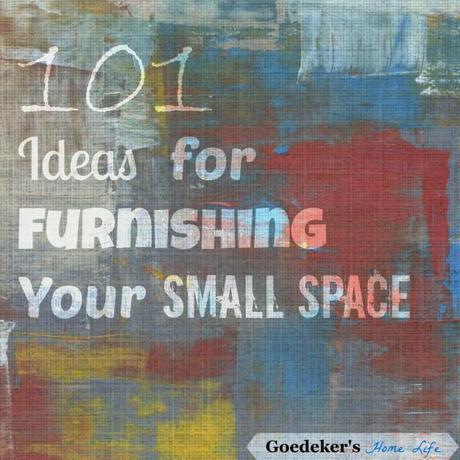
Contrary to how it may sound, there are plenty of positives to living in a small home. It generally means you have lower rent or mortgage payments, and it decreases your utility costs and property taxes. There is less space for you to clean indoors and not nearly as much outdoor maintenance, if any. Not to mention you are always close to the kitchen!
Even dorm living can be a good thing. Sure, you will probably not be fortunate enough to have a room to yourself, but for many this hardly matters; it is your chance to take a step of independence and create your own home-away-from-home.
No matter your motivation – whether it is concern for the environment, moving away for college, downsizing later in life, or budget constraints – all of us have to deal with living quarters that are less than spacious at some point in our lives. The key is to make these places feel welcoming and familiar, not cramped and uncomfortable.
Here we have collected advice and ideas for furnishing your small space – from your dorm room to your first apartment, from a tiny kitchen to a tiny house. There are tips for organization, decoration, storage, and more.
Decorating Your Dorm
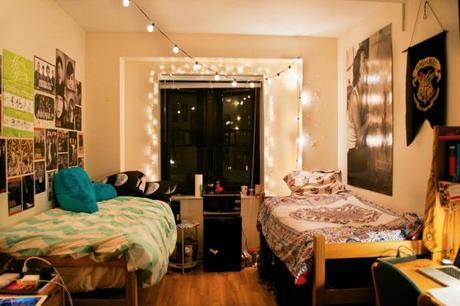
Photo from Dorm Design.
You may have seen our previous post with practical tips for dorm living, which is certainly useful, but crafting a dorm room you’ll love is about more than having the right size sheets or a microwave for midnight snacks.
Before you move in, check with your roommate to see what they are bringing. This will prevent accidentally packing duplicates of shared items, whether they are as bulky as a refrigerator or as small as a trash bin. Any doubles of things that you don’t need will only take up more space.
While you are chatting, you could also decide on a design scheme for your room. Coordinating your bedding or decorative items will make your space feel unified instead of haphazard. However, if you two clearly don’t get along, you can carve out a cozy nook that is all your own.
In terms of decorating, wall art is a great choice, but you should know your dorm’s guidelines before you begin. They will determine how you hang your pieces; nails are generally out, as are push pins or tacks, but tape, command strips, and sticky tack may be viable options, depending on the building.
Try not to unnecessarily take up space with knick knacks, throw pillows, or other decorations. Use functional items you already planned on bringing with you to decorate, such as books with colorful covers or a collection of beautiful jewelry.

Photo from Dorm Design.
A couple of things many sources recommend pouring money into when furnishing your dorm are a good comforter and a board you can write on or pin things to. A good night’s sleep is vital in college, so a comforter that is soft, warm, and durable is a worthwhile investment; one in a pretty color or with an eye-catching pattern never hurt either. A dry erase board, magnetic bulletin board, or memo board could help you remember homework deadlines, extracurricular events planned, and any other details of your schedule. Or they can display mementos like concert tickets or photos with friends.
Keep your desk organized. It goes without saying that you should try to keep tidy as a general rule, but your desk is often the center of activity in your room. It is a table for meals, a work station for homework, and an entertainment center for video games or late-night Netflix marathons. If it becomes cluttered or messy, it will add stress to your life and make your room as a whole feel less welcoming.

Photo from Dorm Design.
Remember that some items can pull double duty. For example, a short bookshelf could also provide you with a nightstand. An ottoman could be used as extra seating, a coffee table, or a foot rest, and some models even have storage space hidden inside. Basically, the more you want to bring, the more you will need to optimize your storage. Use everything and everywhere possible for storage; don’t be afraid to get creative.
Seek out alternatives for things you want that would take up too much space. Instead of a couch, get a comfortable chair for relaxing or reading. If you can’t fit your TV in your room, watch shows or movies online. Or if there are shows you want to watch live, there is probably a television available in your dorm’s lobby.
Overall, don’t treat your living situation like it’s temporary. Make your room feel like home and allow yourself to get settled in; this can help reduce any homesickness or anxiety. Create a personalized organizational system that works for you. Alter the layout of your furniture if the school’s default arrangement feels unnatural or awkward. Cover your room in photos of the people, places, and things that matter the most to you.

Photo from Dorm Design.
Additional Resources
- Crazy College Rooms: Decked-Out Dorms and Apartments – This entertaining slideshow features high-tech room upgrades, extremely detailed themes, roommate pranks, and more.
- Simple Art Solutions for Dorm Walls and Other Small Spaces - Some helpful rules of thumb for hanging up artwork.
- 100 Totally Awesome DIY Projects for Your Dorm Room - A massive list of projects and links to instructions for each.
Arranging Your Apartment
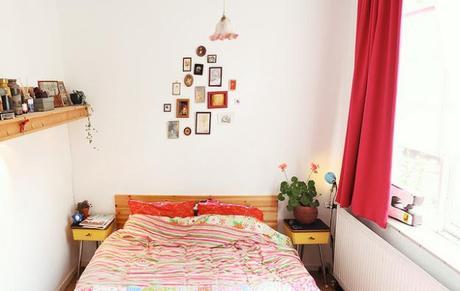
Photo by Flickr user Suzette Pauwels.
Whether it is your first apartment or your fifth, you are undoubtedly well-aware that you’re working with a limited amount of space. How do you gracefully transition from living at home to renting your own place? How do you share a space with a friend or significant other without feeling tense or claustrophobic? Here’s how to turn those few square feet you’ve been granted into a sanctuary.
First, you need to think ahead. After choosing your digs and before moving in, sketch the layout of each room. Look at it like a puzzle and determine how all the pieces will fit together. You don’t have permission to do major renovations, such as taking out walls or widening doorframes, so you’ll have to keep your measurements and limitations in mind. If that couch you’ve been eyeing really won’t fit through the door, you’ll have to go with something else. Work with the proportions of each space. If you have low ceilings, it’s probably best not to get tall furniture.
This doesn’t mean you should shy away from thinking big. Many designers say that too-small pieces of furniture seem to float in the middle of a room, but larger ones serve to ground a space. However, don’t go overboard and overcrowd a room. This goes for oversized wall art as well. One large painting can make a statement, but too much artwork can be overpowering.
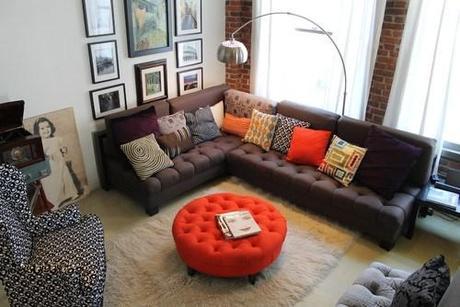
Eclectic Living Room by Los Angeles Home Stagers Madison Modern Home
Know your priorities. For instance, if you truly plan on having guests stay over often, invest in a futon or daybed that can double as a couch in your main room. Get multipurpose pieces. You don’t need a table and a desk if one will do the job of both. If you really want a coffee table, get a trunk or something with added storage so you aren’t wasting space.
Look at everything with a critical eye. If eating meals together at a table is important to you, find something else that you could do without to make space for it. Don’t be frivolous with your use of space, and don’t keep furniture around “just in case.”
Make the most of your wall space. This goes beyond practical storage solutions like floating shelves or wall hooks. Designers recommend using mirrors to create the illusion of space and make the room seem bigger. Artwork is the best way to display your personality, but it should be handled well. Don’t hang art in the middle of a wall, which emphasizes the size of your space, but slightly off-center. Another good suggestion is to put up a miniature gallery instead of individual pieces.
Modify your decorating. Since you can’t change the carpet, get an area rug. Painting the walls is often out, so add color in other ways. Just because there are rules you must abide by does not mean that customization is impossible – you just need to be a little more inventive.
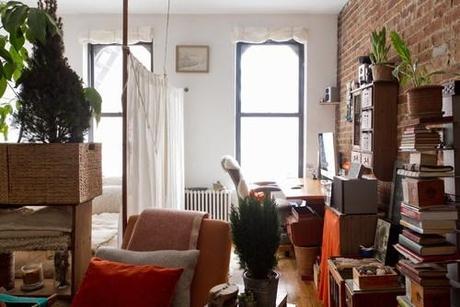
Eclectic Bedroom by Brooklyn Photographers Rikki Snyder
Work in zones. Use screens, bookshelves, or other furniture to split your space up into different “rooms.” Dividing your apartment into functional areas will make it feel less like a dorm and more like a home.
Craft an entryway. Create a drop spot for coats, scarves, keys, and other items you carry that leads into the rest of your apartment. Maybe even include some sentimental decorations or a serving cart for drinks. This will make it feel like a welcome retreat.
Organizing & Outfitting Small Rooms
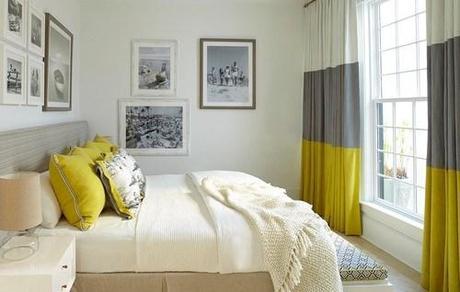
Beach Style Bedroom by Atlanta Architects & Designers Musso Design Group
Dorms and apartments aren’t the only places you are greeted by a serious shortage of square footage. You may be living in the house of your dreams and everything is lovely… but the kitchen is tiny. Or your kids’ toys are spilling over into the rest of the house and you desperately want to get them under control.
Here are some storage solutions and decorating suggestions for the smaller rooms in your home.
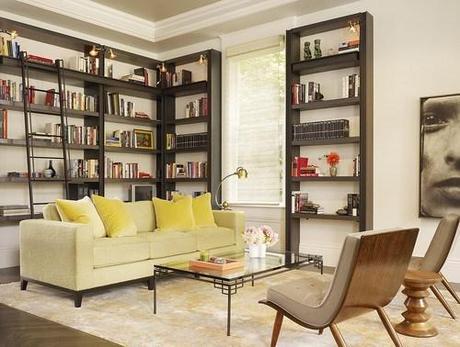
Modern Living Room by San Francisco Interior Designers & Decorators Chloe Warner
The Living Room – In terms of organizing, bookshelves are always a great idea. You could also opt for lining your walls with floating shelves. To make the room feel more spacious, try using reflective furniture constructed from glass or metal. This makes the furniture appear to take up less space. Or, if you need as much storage as you can get, instead invest in a coffee table that will double as storage, like a steamer trunk or an antique chest.
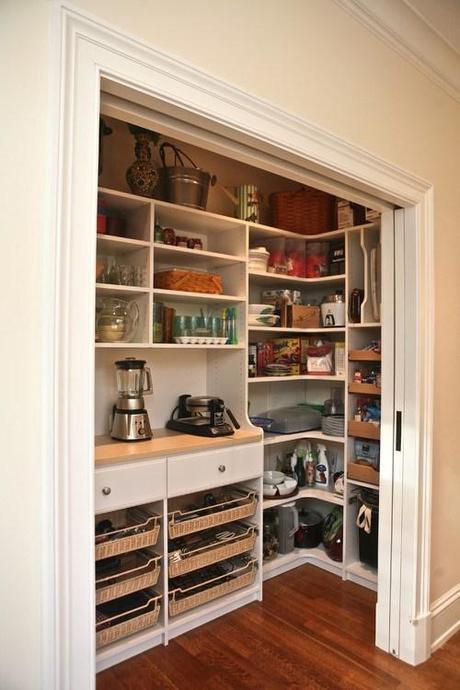
Traditional Kitchen by Weymouth Closet & Home Storage Designers Marie Newton, Closets Redefined
The Kitchen – Storage tips for small kitchens are seemingly endless, but here are a few good ideas to get the wheels turning:
- Use drawer organizers for your utensils.
- Install floor to ceiling cabinetry.
- Shop for smaller appliances.
- Hang a wall-mounted pot rack.
- Put infrequently used items in baskets.
- Hide drawers in booths or benches.
- If you have a kitchen island, add cabinets or shelves to it.
- Keep appliances on your counter only if you use them often.

Photo from DIY Enthusiasts.
The Bathroom – One trend you will see all over the web is putting together a bathroom storage ladder. These can hold anything from clean towels and wash cloths to assorted soaps and shampoos. Another unusual fix is installing hidden compartments around your bathtub. Simply open them up and tuck your toiletries inside.
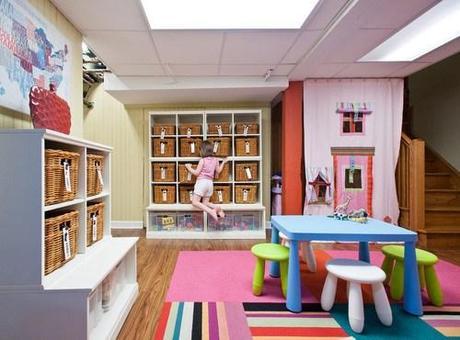
Contemporary Basement by Oak Park Interior Designers & Decorators Amanda Miller Design Studio
Your Kid’s Bedroom – Keeping this mess in order is probably one of the hardest jobs of all. But don’t worry, we have a bit of useful advice:
- Look for good quality over cutesy designs when it comes to storage. Durable containers enable you to reuse them from child to child.
- Labeling your storage containers can help you stay organized, and it gives your child practice reading.
- Invest in a play table instead of a desk. These provide less of an opportunity for clutter to collect.
- Build a fun headboard for your child’s bed to create even more storage.
- Try over-the-door shoe organizers or storage bags for keeping their toys together.
This post at Hello Little One has even more tips – including ideas for how to store your belongings out of the reach of your curious child.
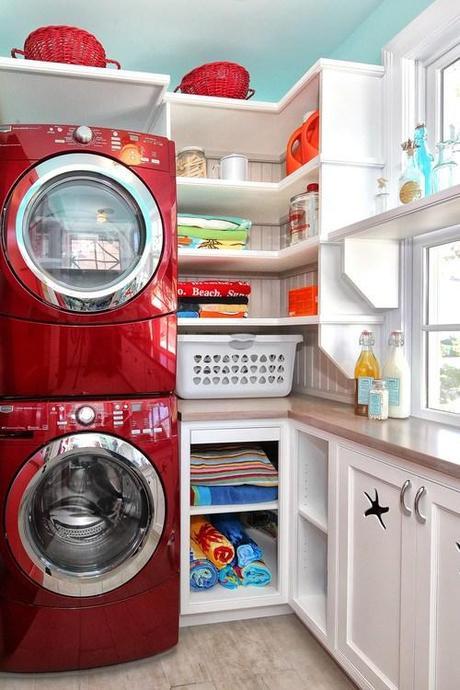
Traditional Laundry Room
The Laundry Area – A good route to take is purchasing a compact washer and dryer. Apartment size appliances are a popular option for those who don’t have a dedicated laundry room. Another solution would be to buy a stackable laundry pair. For DIY projects such as a fold-away ironing board, storage pedestal, concealing curtain, and more, check out this compilation of resources at Remodelaholic.
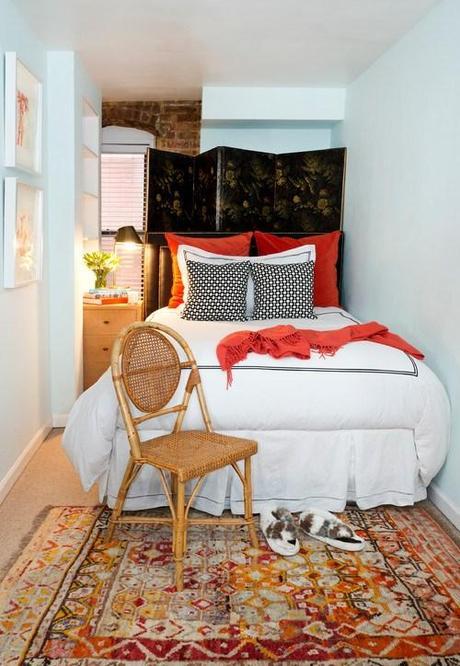
Eclectic Bedroom by New York Interior Designers & Decorators J+G Deisgn LLC
Your Bedroom – Leave this space as uncomplicated as possible. It is supposed to be a refuge, so try not to store much in your bedroom; emphasize warmth, comfort, and peace. To do so, you should strive for symmetry and simplicity in your design. Only have one focal point, whether it is an accent wall, art that makes a statement, or bedding in a bold color. There is no need to shy away from at least a little whimsy, however; you can still showcase your personality in small ways.
Thinking Tiny
The small house movement has been gaining momentum in recent years. If you haven’t heard of it before, the short video above will give you a pretty good idea of what it’s all about. Or, if you have the time to spare, Kirsten Dirksen recorded a full-length documentary which is available to watch online.
This trend, also called the tiny house movement, is the ultimate in small-space living. Hundreds of free-spirited people, sick of being tied to stressful full-time employment, choose each year to pay off their debt, quit their jobs, and eliminate their excess stuff. Then the final step in simplifying their lives is to buy or build a tiny house.
This task may sound too monumental and full of uncertainty to even entertain. Many people see visions of themselves dirt poor and hungry, and they become too terrified to take the leap. How do you go from sprawling across a space and clinging to your possessions to ditching the clutter and downsizing? And what if things don’t turn out as well as you’d hoped?
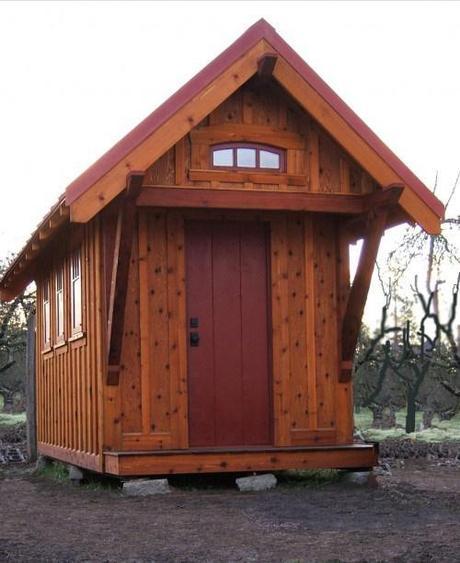
Rustic Exterior by Other Metro Architects & Designers Tumbleweed Tiny House Company
Luckily for you, there are plenty of people who have been there before blogging about their experiences and sharing information vital to successful tiny house living. Andrew Odom of Sustainable Baby Steps has published a series about tiny homes. There are guides about moving out, building your house, and designing for optimal storage.
It is important to plan the storage during the construction process. This could be toe-kick drawers beneath your cabinets, cubbies under counters or benches, hidden storage under the stairs – your options are virtually limitless.
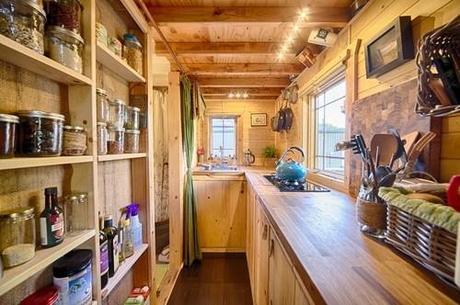
Rustic Kitchen by Seattle Photographers The Tiny Tack House
These houses have to be space-conscious in every way they can, including methods of getting from room to room. Conventional stairs may prove too impractical, so use an innovative alternating stair design or a simple ladder to reach a loft instead. Installing pocket doors, sliding doors, or even curtains is preferable in comparison to the space used by traditional swinging doors.
Most of the tiny houses you will see online aren’t much to look at in terms of interior design, but don’t let that discourage you. If you want a gorgeous home inside and out, you’ll just have to get creative – on a smaller scale.
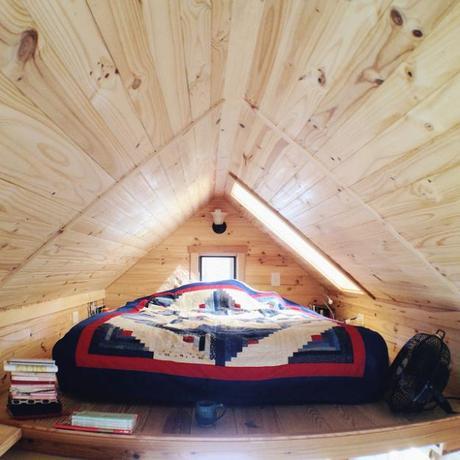
Photo by Flickr user Tammy Strobel.
Additional Resources
- Incredible Tiny Houses - Browse a remarkable collection of tiny houses, including layout sketches, interior photos, and video tours.
- Hobbit Holes – The company Wooden Wonders started out building Hobbit hole chicken coops, garden sheds, and playhouses, but customer demand prompted them to create large structures such as guest houses and tiny cottages.
- Tiny House Furniture – This archive has multipurpose furniture designs, room ideas, and more.
- Tiny House Appliances – Check out some reviews of space-saving appliances, many of which can be purchased from Goedeker’s.
Multifunctional Furniture
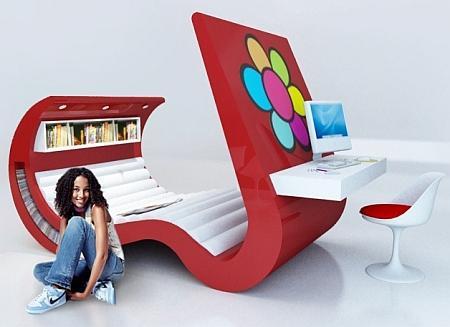
Photo from HomeDesignInterior.com.
While many of these designs only exist in concept, are totally unique and not for sale in any store, or are completely out of the average person’s price range, they are still exciting to look at. And who knows, maybe some of these images or videos will inspire you to be more efficient with the use of space in your own home!
Resource Furniture: Italian-Designed Space Saving Furniture – Check out these remarkable and versatile creations by Resource Furniture, whose tagline is “Space. Reinvented.”
“Architectural Furniture” by Kenchikukagu – These foldaway living spaces include a kitchen, a guest room, and an office.
“Casulo” by Marcel Krings and Sebastian Mühlhäuser – Who would have thought that every piece needed to create a fully-furnished room could fit in such a small and easily transported package?
Other Incredible Multifunctional Furniture Designs
- Extraordinary Multifunctional Furniture for Small Spaces - Innovative and visually interesting pieces of furniture by various designers.
- Room in a Box: Ultra-Portable Piece of Pull-Out Furniture - This small box can be transformed into a desk, chair, table, and even a bed – and it is lightweight and compact enough to be carried by a single person.
- The Living Cube - Designer Till Könneker creates customized living cubes for small spaces. He uses his own personalized cube at his apartment to house his bed and TV, as well as store his vinyl collection, clothing, and shoes.
- Bookcase Chairs and Furniture - A variety of furniture designs that are built to hold books, magazines, and any other small household items.
- Drawer Kitchen - This prototype was submitted to the 2008 Electrolux Design Contest. Though it is not currently available on the market, it is a nifty concept to consider.
General Tips
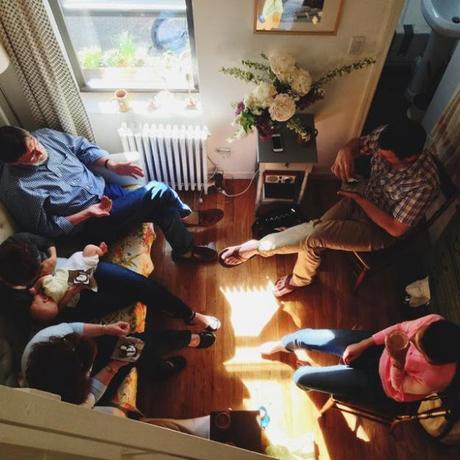
Photo from A Cup of Jo.
Much of the advice and inspiration listed has been highly specific, but here are some more general guidelines that could be used in any small space and on any budget.
First of all, living in any of the places listed is easier if you declutter your possessions and discard what you don’t need. For college kids, the equivalent would be leaving some things at home when packing – but remember, soon enough you’ll be back home and you’ll have that mess on your hands again. It doesn’t magically vanish while you’re away.
There are many common areas, such as your wardrobe or your sentimental keepsakes, which can be tackled. Some things may take more time and mental energy than others to sift through, but don’t let yourself get overwhelmed. Address the clutter a few minutes each day and soon enough you’ll begin to notice a difference.
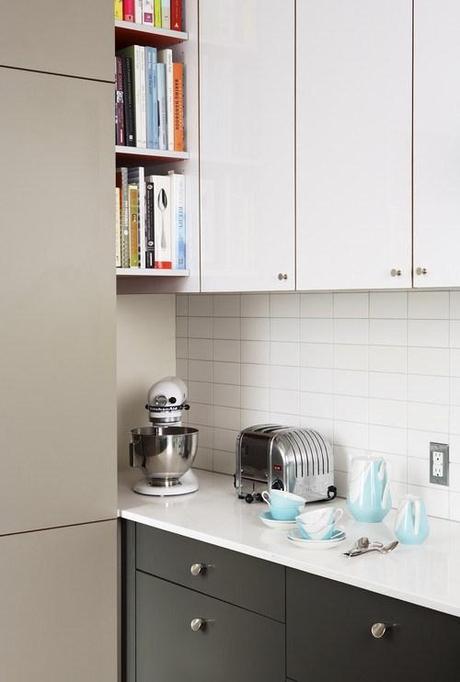
Modern Kitchen by San Francisco Architects & Designers John Lum Architecture, Inc. AIA
When it comes to optimizing your storage, make use of all the available space you have. There are plenty of unusual storage solutions out there that most people wouldn’t think of – such as inside a closet or cabinet door, on the sides of a dresser or bookcase, or in corners where cabinets can’t be installed. There are all sorts of nooks and crannies that you could take advantage of.
There are a couple of places you should always keep in mind for storage. The first is the space under beds. It is a prime location for hidden storage, such as extra bedding, seasonal clothing items, children’s toys, and even strange items that don’t have anywhere else to land, like gardening tools. The other space is beneath the stairs. If your home has a basement or multiple floors, go ahead and use all that dead space under the staircase.
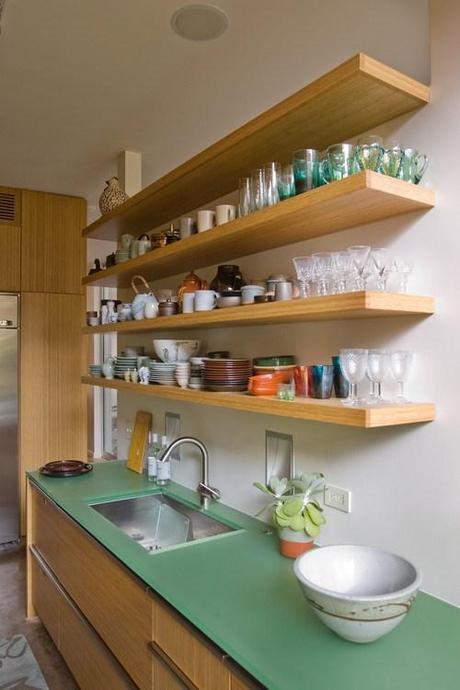
Contemporary Kitchen by Birmingham Architects & Designers Erdreich Architecture, P.C.
Remind yourself that you can also think vertically. Invest in bunk beds for your apartment if you are sharing a room with a friend. As mentioned previously, you can put up wall hooks or floating shelves for holding all manner of smaller items. Don’t leave a wall bare if it could be serving a better purpose.
Add to existing fixtures in your home. Any cabinets or closets can have additional dividers, shelves, or wire organizers installed inside to help maximize the space.
When it comes to storage containers, square-shaped ones are the most efficient choice. While those round, multi-colored containers you’ve been mulling over may look cheery and fun, ultimately they are space-killers.
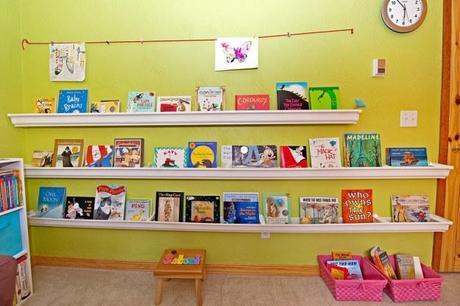
Photo from Little Green Notebook.
Get creative with items meant for other spaces. This could apply to anything at all designed for a specific use, but here I have listed a few:
- A tiered dessert or fruit stand for soaps
- A wine rack to hold towels
- Shower caddy for office supplies
- Egg crates to separate jewelry
- Rain gutter bookshelves
- Spice racks for toiletries or children’s items
- Hanging garden baskets on interior walls
- Cutlery organizers for nail polish
- Dish drainer to sort mail
Do a bit of upcycling. Here are a handful of examples of the hundreds of things you could reuse:
- Coffee cans
- Mason jars
- Cereal boxes
- Oatmeal containers
- Shoe boxes
- Orphaned drawers
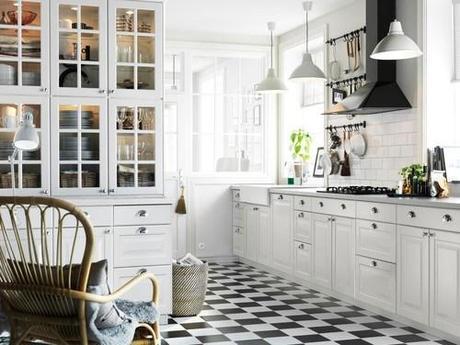
Traditional Kitchen by Other Metro Furniture & Accessories IKEA
To make your space feel less claustrophobic, enclosed, or monotonous, break up your storage. Find a good balance between concealed and open solutions. Don’t have a room full of windowless cabinets, but don’t have shelf after shelf with your belongings on display.
Resist overstuffing your space. Cut down on the collections you curate and the amount of accessories you own. Don’t cover every square inch of your walls with artwork, no matter how many beautiful pieces you’ve amassed over time. Even if everything you own is clean and presentable, the more things that fill a space, the more cluttered that space will appear. Leave open areas around your collections, and have a dedicated gallery wall instead of crowding every surface with art.
Design multipurpose rooms. It isn’t only furniture that can have dual functions but rooms as well. Murphy beds are an excellent example of this. They can fold out for the nighttime when you need them, but during the day they can be cleverly hidden and leave room for other activities.
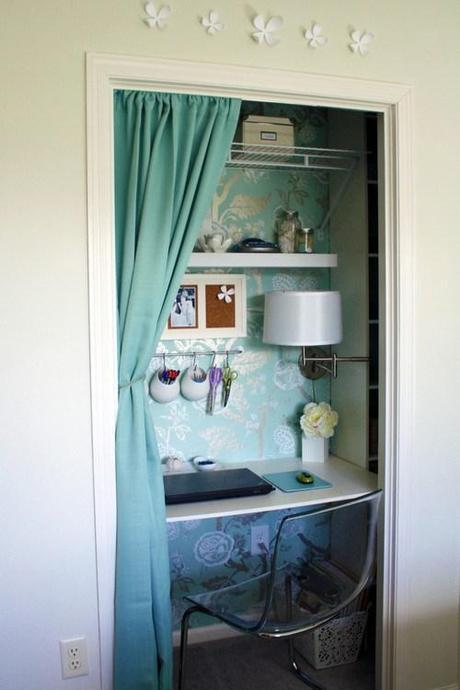
Traditional Home Office by Other Metro Media & Bloggers iheartorganizing
Makeover your closet. If you want your own home office or reading nook but you can’t afford to reserve an entire room for it, tuck it away in an underused closet.
Cover your space with the color white. Many designers emphasize that working with white makes a room feel light and airy, and this truth has been illustrated time and time again. There is no need to drench your entire house in white, but redesigning one area, such as the living room, could make a huge difference.
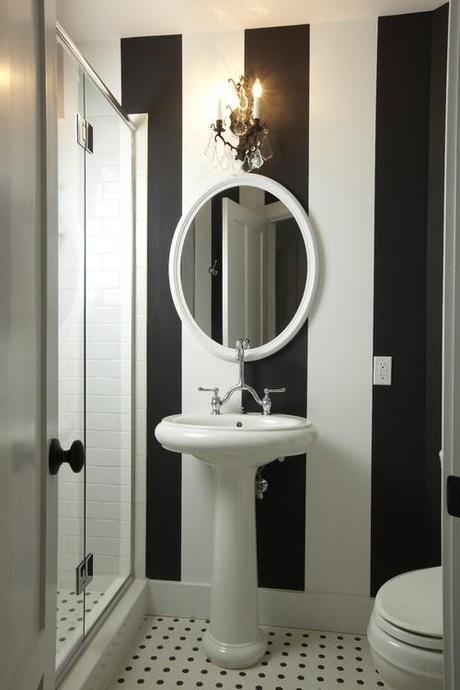
Traditional Bathroom by Saint Charles Home Builders Stonebreaker Builders & Remodelers
Repetition gives the illusion of space. A gallery wall with uniform frames, the use of stripes, or other repeated visuals can easily be implemented into the room of your choice. If you own your home, you could paint the walls with a striped pattern. If not, buy an area rug or put up temporary wallpaper for a similar effect.
Keep your space well-lit. Too quickly, small rooms can start to feel gloomy or heavy, so make sure you have plenty of lighting. You could leave your windows uncovered or use sheer curtains during the day, and incorporate lamps into your decorating for more light in the evening.
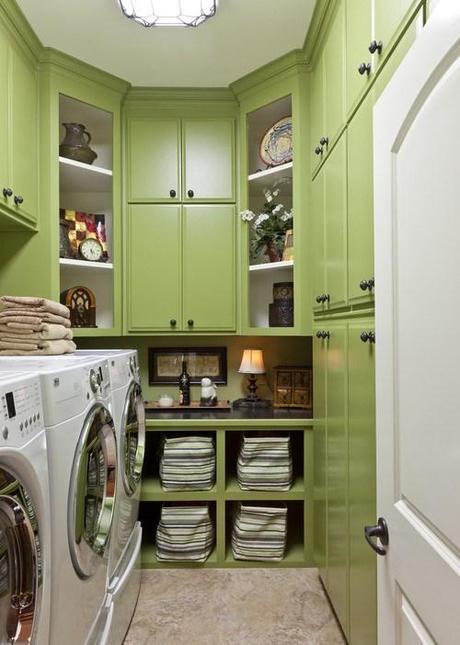
Traditional Laundry Room by Conway Architects & Designers Classically Yours Interiors (CYInteriors)
Create clear pathways. Don’t block the entrance, don’t arrange your furniture awkwardly, and don’t let things pile up on the floor where you have to step over them. Leaving enough space to comfortably move around will keep your space from feeling too cramped.
Above all, stay tidy. Keep each room organized, clean, and clutter-free. It doesn’t matter if you are in charge of maintaining as little as your half of a dorm room or as much as a reasonably-sized house; you’ll feel more at home not only if your space reflects your personality, but also if there is no mess to detract from relaxation or add to your stress.
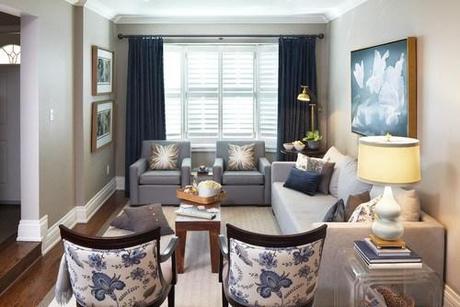
Contemporary Living Room by Toronto Interior Designers & Decorators Sealy Design Inc.
Additional Resources
- 24 of the Easiest Houseplants You Can Grow - If you want to add a splash of color and vitality by decorating with plants, but you don’t have much time to spare on tending them, maybe consider some of the options on this list.
- Super Inexpensive & Simple DIY Storage Solutions - Even more ideas for DIY projects that will cleverly store your belongings.
If you enjoyed reading this post or found it helpful, please consider sharing!

